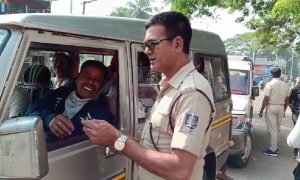Crackdown on Bangladeshi ‘infiltrators’ in Kendrapara

Kendrapara: A day after two illegal Bangladeshi immigrants were arrested along with seizure of weapons prompting tightened surveillance across major roads and rural pockets in neighbouring Jagatsinghpur, police in Kendrapara district Monday cracked down on suspected Bangladeshi infiltrators. Authorities have been verifying identity documents and inspecting luggage carriers in buses, cars and other vehicles across key points including Duhuria, Garapur, Pattamundai, Rajnagar, Rajkanika and Mahakalapara areas.
With several Bangladeshi settlements believed to exist across the district, residents say ground-level screening is essential. SDPO Jyotiranjan Gouda said police forces were placed on alert following the recent car blast near Red Fort in Delhi, with intensified surveillance now ongoing in all police station limits. Every vehicle is being screened, he said, though achieving complete success remains a challenge without community support.
Police have also launched awareness campaigns urging landlords to submit full details of tenants at the nearest police station. Gouda said cooperation from residents would make the identification of illegal immigrants significantly easier.
Local intellectuals and social workers, including Pratap Mohanty, Banambar Sahu, Manoj Nayak, Prashant Nayak and Radhakanta Mohanty, noted that Kendrapara has long been identified as the district hosting the highest number of illegal Bangladeshi immigrants in the state. Despite this matter being raised repeatedly in the Odisha Legislative Assembly, the three Marine police stations in the district — at Jamboo, Talchua and Tantiapal — lack the manpower and infrastructure needed to effectively monitor infiltration routes, they said.
Historical records show that 1,237 Bangladeshi nationals were regularised during the Partition era, but census data and recent estimates indicate that the number of Bengali-speaking residents has grown significantly — from over 76,000 in 2011 to well above 1 lakh now. In Mahakalapara alone, 1,551 migrants identified in 2005 received deportation notices that were never enforced.
Community leaders say illegal settlements have expanded under political patronage, including encroachment on forest land. Some migrants allegedly obtain ration cards, use school admissions as proof of residence and even secure government jobs by exploiting administrative loopholes. Rising numbers, they claim, have created occasional law and order issues and contributed to a decline in Odia usage in peripheral regions.
Given the infiltration through sea routes and highways, activists recommend involving Anganwadi workers in rural identification drives, saying many hidden cases would surface.
Orissa POST – Odisha’s No.1 English Daily
News